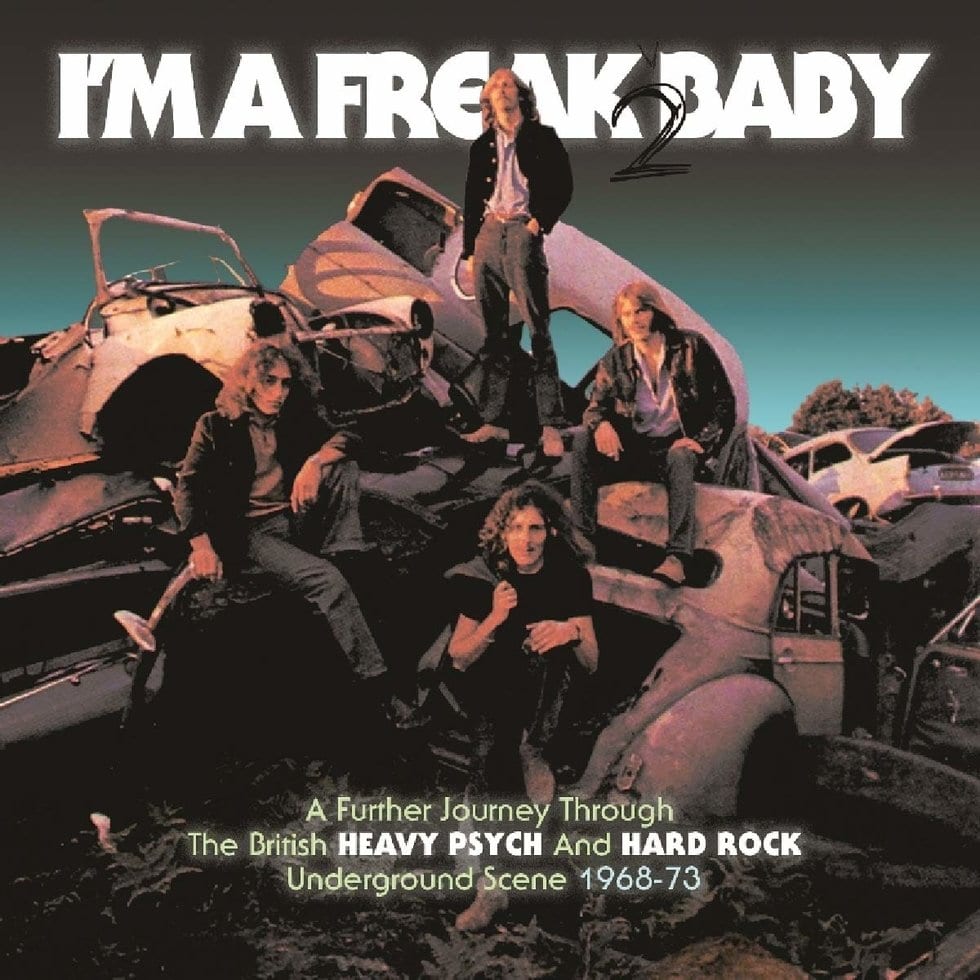
David Wells and John Reed continue to impress with the ever-expanding collection of late 1960s/early 1970s UK music anthologies that they have been producing for Grapefruit Records over the past several years. These three CDs in a clamshell box with a comprehensive mini-booklet of liner notes have covered numerous genres of the times including folk, psychedelia, and hard rock. Many times, there is ample overlap among the performers and styles because all these genres were percolating at the same time in a relatively small place. Each collection is a winning mix of curatorship and historical research. Their latest collection, the sequel I’m a Freak 2 Baby, picks up where the hard rock and proto-metal compilation I’m a Freak Baby left off.
Like that 2016 collection, I’m a Freak 2 Baby focuses upon the British bands formed in the wake of Led Zeppelin, Black Sabbath, and Deep Purple, a heavily creative era where the folk and psychedelic elements of the rural music scenes merged with the harder, working-class edge of the UK’s urban industrial centers to form an edgier, sometimes angrier sound. As Wells’ notes, “Suddenly everything was longer, louder, hairier, and heavier.” Listening to this mix of mildly familiar and utterly obscure tracks, one hears elements of glam, heavy metal, punk, and even progressive rock swirling into globular coherence.
It’s not uncommon to slag off heavy metal or hard rock as static or overly formulaic in comparison to other more critically friendly genres, but there’s a wealth of experimentation and surprise here, with ample signposts pointing to where some of the most exciting forms of UK rock music would be going as it continued its development. The Move’s “Turkish Train Conductor Blues”, for instance, would be a spot-on Roxy Music impersonation but for the fact that the latter band had not yet entered a recording studio when the now Jeff Lynne-led Move released their 1970 Looking On record. That Lynne, Roy Wood, and Bev Bevan chose not to follow this path but rather formed the oddly successful juggernaut that became the Electric Light Orchestra is a testament to just how varied and eclectic the creative juices were flowing at this time as rock and roll reinvented itself into a dozen splinter factions.
They don’t merit mention among the comprehensive liner notes, but it can’t be emphasized strongly enough (particularly following the global success of the Bohemian Rhapsody bio-pic) that Freddie Mercury and Queen sprang from this fertile freak underground. Had that band imploded following its first foray into the UK top 30 with “Killer Queen” and never gotten to record their now classic follow up to Sheer Heart Attack, they would fit just fine here as one of Britain’s great coulda-beens, of which the collection has many (I’d suggest “Brighton Rock”). That they did record A Night at the Opera and all that followed, doesn’t change the fact that Queen was born of this blissed-out and gloriously pompous, post-psychedelic, proto-metal, throw-it-at-the-wall-and-see-if-it-sticks splash in time. Anyone who enjoys that band’s first five records will find much to enjoy here and will, no doubt, be sent off on a good dozen quests to find more work from many of the groups here, who may not have earned Queen’s regal stature but nonetheless served the court well. They will certainly enjoy Warhorse’s “Back in Time”, which evokes Brian May’s guitar pyrotechnics from the previously mentioned “Brighton Rock”.
These were exciting and creative times, where numerous genres were exploding in newfound experimentation, so much so that an anthology like this might serve notice that we need to revise the oft-written narrative that punk was a necessary replacement to a vapid music scene if this stuff is indicative of what was happening in 1974. Yes, bands like ELP, Genesis, and, well, Yes and their progressive brethren formed a ponderous and prodigy-centric branch from this era, but then so many of the working-class kids making the music we hear here who didn’t go on to the lives of limousines and tour riders provided more inspiration than counterpoint to the punk generation. This is underground music, after all, while the punks were responding to the lame top-of-the-pop-charts of the time. But Stray, the Rats, Wicked Lady, and Slowload got nowhere near the charts, and their music as presented here is fresh, exciting, and vitally alive. Listen closely to the Pistols or the Damned or Stiff Little Fingers or Sham 69 and you will hear echoes of these guttural tracks.
Being of its time and place, though, there’s a lot of cock-rock to be found here, and women exist mostly as objects or foils among of the songs. Burke Shelley smugly sings, “you better be mine” in Budgie’s charging rocker “Guts”. Meanwhile, Tear Gas advertise “Woman for Sale”, and Samuel Prody (band) seem incapable of finding any additional rhymes for “eyes” beyond “lies” and “thighs”. There’s a more noticeable paucity of women players among these bands than is found on other genre compilations from the era that Grapefruit has released. Woke music this is not. But this is also music that deserves to be enjoyed for what it is more so than what it isn’t, and what it is is a thick slab of balls-to-the-wall heavy noise, start to finish, loud, brash, and custom-made for its audience of disaffected youth. Like its predecessor, I’m a Freak 2 Baby is both exhaustive and exhausting, and damn near necessary for hard rock and early metal fans.

